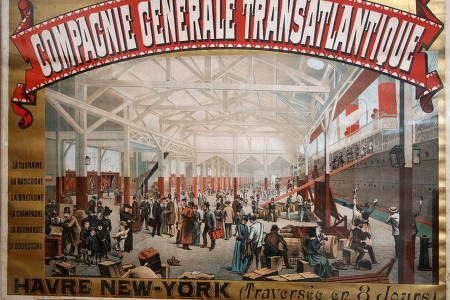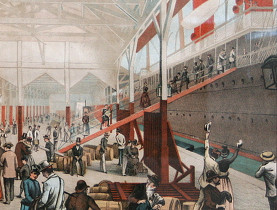Migrations interview: Part four

There were two sides to the migration coin with both winners and losers.
But as Giorgio Cheda argues in this part of the interview, the mass movements abroad, especially those to California, must be seen as benefiting both the emigranti and those who remained in Ticino.
swissinfo: So over many decades, people continued to migrate to California – but not only to California, to Argentina as well between 1880 and 1914 and to London. What impact did the loss of all of these people have on Ticino and the people left behind?
G.C.: As always, there were both positive and negative aspects. In my opinion the net result was positive. I know that not everyone agrees with my view, but let me explain. There were negative aspects, of course, which were borne mainly by the women, because emigration created an imbalance of the sexes. It was mainly men who left, especially in the case of Australia and the first waves of people going to California, and the women were left behind. So these women could not get married and it fell to them to perform all sorts of heavy tasks, which also affected them physically.
I’ve seen some doctors’ reports in which they say that women had difficulty in giving birth because they were obliged from childhood to carry heavy burdens up and down the mountainsides carrying, for example, cheese, ricotta and butter from the alpine pastures at 2,000 metres above sea level to the market in Locarno. All this work fell on the women’s shoulders. Or think how they had to make hay in the woods to be able to feed a cow or two during the long winters. This was very hard work for a woman, and very dangerous.
These hardships have been illustrated very well by the painter Vanoni, who has left a whole series of ex voto images in our churches graphically portraying the sufferings of the women who were forced to perform these tasks.
So, on the one hand, there was this imbalance of the sexes, which weighed most heavily on the women. But, on the other hand, you have to remember that the departure of many people, mainly to California, also meant fewer mouths to feed with the limited supplies of food that could be produced in our mountains, because the arable land there could produce only a limited amount.
Then senseless deforestation caused partly by politicians out to make a quick profit led to the loss of quite a few hectares of arable land. Then there was the damage caused by the flood of 1868, the year in which emigration from Ticino peaked. The people were demoralised. They no longer saw how they could survive in a valley as poor as the Val Verzasca or the Valle Maggia, so they preferred to go to California. Therefore there is also this very positive aspect: emigration as a safety valve, an outlet for a population that was increasing in numbers and could not make a decent living from its native soil.
swissinfo: Were there other positive aspects?
G.C.: A good proportion of those who emigrated to California may have lived a hard life as cowhands, ranching, working all hours of the day, but they were also able to acquire land at an affordable price, especially between 1860 and 1910 –something that would have been unthinkable here in Ticino.
So clearly this explains how a thousand or so of these 27,000 Ticinesi who went to California were able to purchase, in total, an area almost as large as the Sopraceneri (upper part of Ticino): 1,800 square kilometres of land. This is putting together all the small, medium and large-size ranches that the Ticinesi purchased between the border of Oregon, up in Humboldt County, and San Diego and the Mexican frontier, and especially of course in certain counties such as Marin, Sonoma, Napa, the Salinas Valley, San Luis Obispo, the Santa Maria Valley, or on the Sierra, in Plumas County and so on, where the largest and most important “colonies” of Ticinesi became established.
Not forgetting San Francisco, where already in the 19th century – before the San Francisco earthquake – there were more than 500 Ticinesi living. Obviously they were not working on ranches but in the various trades and professions, because the children of the first ranchers had been able to attend college or university, and so they had settled in the major cities – cultural capitals, we might say – of the American West.
We could put it another way: if today we visit the Ticino valleys of Sopraceneri, we find many fine houses built between 1880 and 1910-15, which were paid for with the dollars earned in California. The finest houses in the Valle Maggia and the Val Verzasca, and indeed in other areas such as the Leventina or the Riviera, were built during that period thanks to the savings made by the ranchers in California, or rather by the emigrants, since not all of them were ranchers, of course.
They managed to save a certain amount of money, returned to Ticino and built their houses. Unfortunately, there is a negative side to this, which is often passed over: the failure of the banks. Let us not forget that in 1914 practically all the banks in Ticino collapsed. This represented a loss of a cool SFr40 million, as valued at that time. And almost all of these 40 million, in my humble opinion, were savings remitted by emigrants, largely saved in California – also in Argentina and other places, but most of it had been saved in California.
Years ago, I tried to research this matter in greater depth, but unfortunately I had to give up because all the documentation regarding the 1914 bankruptcies had been destroyed.
But I hold this view because I have read many of the emigrants’ letters and have some knowledge of what happened in those years. In particular, we must consider the importance of the Banca Svizzera-Americana, established by the Ticinesi in San Francisco with branches in other towns in California and a centre in Locarno. From Locarno, the Banca Svizzera-Americana reached out into the valleys of Ticino, and played an important role in handling the savings that were regularly remitted from California.
So when the banks crashed, many families lost enormous sums of money, and this must be counted as one of the negative aspects of the (emigration) phenomenon.
Cont.
Ticino population:
1850: approx. 118,000
1900: 139,000
1950: 175,000
2000: 307,000
Today: 330,000
(Official canton Ticino statistics)

In compliance with the JTI standards
More: SWI swissinfo.ch certified by the Journalism Trust Initiative













You can find an overview of ongoing debates with our journalists here . Please join us!
If you want to start a conversation about a topic raised in this article or want to report factual errors, email us at english@swissinfo.ch.